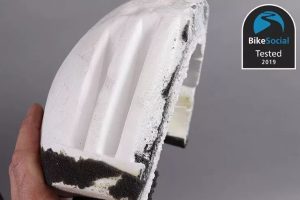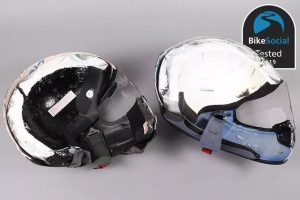How much is the right price for a helmet? Motorcycle helmets from brands such as LS2, MT, Box, etc. can be bought for just £50, but is it really worth spending £200, £400, or even £700 on an expensive helmet from Arai, Shoei, Schuberth, etc.?
It’s hard to tell from the pictures above why there’s nearly £300 difference in price between the two helmets.
When you go to a gear store and look for a helmet, you wonder why some helmets are more expensive than others. At this point, you ask yourself, what is the best helmet? Today, we will cut open an Arai helmet and a regular helmet to show you the difference between a cheap helmet and an expensive one.

After cutting it open, we can see that Arai’s shell is made of composite fiber and resin, while ordinary helmet shells use a thermoplastic material with lower production costs. Both meet the EU’s ECE 22.05 safety standard.
What is the best material for a motorcycle helmet?
We can see that one of these two helmets is made of ordinary plastic, and the other is made of composite fiber and resin. Of course, this does not simply mean that composite fiber and resin materials must be better than ordinary plastic. It depends on how well they are made. Plastic helmets are often the cheapest on the market, but this does not mean that plastic is safer than composite fiber materials. Some plastic helmets made of polycarbonate are quite strong, impact-resistant and anti-oxidation.
The shell of the regular helmet is above, and you can see that while it is thicker and lighter, it is made of plastic and is not as sturdy as the Arai helmet below.
Arai’s outer shell is also very strong. Its design concept is to disperse the impact force to a larger area, thereby reducing the force on the soft lining and reducing the damage to the head. The fibers inside the outer shell are arranged in a „bird’s nest” style. Each Arai helmet uses 2 layers of this „super fiber” structure, which is 30% stronger than ordinary glass fiber.
This fiber can be laid in different directions to better resist cracking caused by impact. This is more complex than traditional fiberglass materials, so the production cost is higher and much more expensive than ordinary plastic helmets. Of course, different helmets also have their own ways to make helmets.
Arai uses a composite laminated fiber construction, and the edge bands in the picture require a more expensive manufacturing process.
This makes Arai helmets heavier than lightweight carbon fiber or plastic helmets, and while you can feel the difference, in 20 years of testing I have never found a helmet to be uncomfortably heavy.
The only place where the helmet may add weight is its shell, and a strong shell makes it heavier. Arai’s helmet shell technology is used as some of the heavier space structures in the construction, and the complex laminated fibers make it a lattice-like network structure to increase the strength of the helmet shell.

Many Arai helmets have a reinforcing band above the visor, which increases the strength of the opening above the visor and allows the use of a thinner liner. The benefit of this is that when you are hunched over the motorcycle, you can see more through the top of the visor, which is important.
Of course, other advanced helmets also have their own technologies. Although one helmet looks very similar to another, different processes can have a great impact on the manufacturing cost of the helmet shell.
Under the motorcycle shell, there is also a layer of polystyrene as a buffer layer.
Are all polystyrene liners on motorcycles the same?
This soft shell is typically expanded polystyrene and can vary greatly from helmet to helmet. The simplest one is a single-piece liner with a soft top and channels on the back. The different densities of the two parts will also affect the transfer of force during testing.

Because the composite fiber resin shell is very strong, the inside should be softer, increasing the comfort of the helmet and effectively reducing damage to the head. All helmets sold in the UK and Europe need to pass the ECE 22.05 standard. Arai uses a single liner with completely different density structures in different parts, which of course makes the manufacturing cost higher.
I’ve boosted the saturation in this image to more clearly see the three different densities of padding, the softest part is white, followed by green, and the hardest part is blue, and of course even the blue is softer than the cheaper polystyrene.
Of course, the production cost of any helmet is included in its selling price. For example, many helmets from top brands such as Arai and Shoei are handmade, which is not cheap. To some extent, this explains why their helmets are so expensive. Of course, you don’t have to buy these expensive helmets.
The lining structure of this helmet is very complex, which undoubtedly increases the production cost.
Can you spot the difference in this lining?
Its lining can wick away sweat and keep you comfortable, and prevent bacteria from gathering and emitting odors. You will also find that many cheap or expensive helmets on the market now have removable liners, which also makes it easier to clean the lining.
In order to help air flow, increase comfort and durability, the structure of these liners is also very different. Take Arai as an example, the lining structure in the cheek and skull part is very complex. The lining of ordinary helmets is much simpler. As for whether it is comfortable or not, it depends on your needs.

Does the lining have an effect on comfort? Since I bought my first helmet in 1996, I have found Arai to be very comfortable compared to other high-end brands. If you are on a budget, you have to take your chances, but I have worn a cheaper Duchinni helmet and after wearing it for half an hour, I felt like someone had cut a knife through the top of my head, which was very uncomfortable.
In addition to the shape and lining of the helmet affecting comfort, the thicker and softer the polystyrene padding inside, the better it wraps and the more comfortable your head will be.
Are all helmet visors the same?
The visor of any helmet needs to meet certain viewing angles and clarity, which needs to meet the ECE 22.05 standard. Different designs can also give you more space above or below the visor, increasing your field of vision.
Most helmets now have a socket for installing anti-fog lenses, and the effect of anti-fog lenses is divided into 30 for the lowest, 70 for the middle, and 120 for the top. When you get the helmet, you usually don’t install them directly because they are not safety certified, and during use, they will unknowingly reduce clarity. You need to buy certified anti-fog lenses through formal channels.
Many cheap and expensive helmets have a dual-lens design with a drop-down black visor. This black visor is very useful when you are exposed to direct sunlight. But Arai refused to design such a drop-down black visor because it would create an extra space between the helmet shell and the padding, which would reduce safety. If Arai adopted such a design, it would probably sell more.
A drop-down black visor creates a gap between the helmet shell and the liner.
You will find that no racer will use a helmet with a drop-down visor, because such a design will make the helmet thicker and heavier. Of course, it is illegal to wear a black windshield in the UK, but the police generally don’t care unless you ride like a fool or you have to wear such a mask at night. At night, you can change to a transparent windshield.
Visors are usually made of polycarbonate or acrylic. They need to be very strong, usually they can be bent in the opposite direction without deformation. But you must be careful when cleaning the visor, because some cleaning products can cause serious damage to the visor and make it brittle. Some HJC helmets also have a quick-release design. When you need to replace the visor at some point, HJC can replace the lens more quickly by pressing the buckle.
A good helmet can be very strong, but also provide a lot of air, allowing for better air circulation inside the helmet.
You may find that the padding of the helmet has some hollow sections, which can help improve the airflow inside the helmet.
Of course, more vents and spoilers are not necessarily a good thing. If they are bumped in an accident, the helmet may be offset during the impact, causing damage to the head or neck. The vents of some helmets can be easily broken, but Arai can still maintain an angle when the vents collide.
Are more vents better?
A good helmet will have better air duct design to cool your head and keep you focused at all times. The exhaust port can draw air away.
Some cheap helmets may appear to have a lot of vents, but sometimes they are useless. It should be noted that any holes in the helmet shell will reduce its structural integrity, so the shell must be strong enough to at least meet the ECE 22.05 standard.
Do expensive helmets last longer?
Most helmets have a five-year warranty, but the condition of the helmet depends on how often you wear it. Our motorcycle instructor has been using a Shoei Multitec helmet for the past six years. If you take age into account, it may have expired.
Cheap helmet, more wear and tear
I have been using the MT as my daily helmet. I wear it five days a week for my normal commute, and I use the Shoei less often than before because the MT helmet has poor wind noise control and is very noisy. If I need to travel long distances, I will still wear the Shoei helmet.

The MT helmet is £130, while the Shoei Multitec is £400. The Neotec II in a regular version is also £520. To be honest, the MT is reasonably priced, but after a year of intensive use, it has started to wear out, the lining is starting to fall off, and the black visor has some problems with the closure.
Advanced helmets are more durable
I would say I’ve worn the Shoei Multitec for 100,000 miles, and the MT for 15,000 to 20,000 miles, which is still a lot of time if you’re not wearing the helmet for only seven or eight hours a day, five days a week.
Both helmets perform similarly when the ducts are open, but when you close them the cheaper helmet still has airflow while the more expensive one does not. There is a real difference in noise, comfort, padding and ventilation between the two, and you get what you pay for.
But choosing a helmet still depends on what brand you like and how much you want to spend? It’s like I always tell my students, buy the best helmet you can afford, be sure to try it on, and buy it from a reputable dealer.
Tips for buying a motorcycle helmet:
1. Don’t buy second-hand goods.
2. Read our articles.
3. You can learn about the preferences and suggestions of different people.
4. Try as many different brands and models as possible.
5. Make sure the helmet fits tightly to your head with no pressure points. If you feel the inner shell of the helmet pressing on your head, you will feel pain after an hour.
6. After trying on the helmet, move it left and right to ensure that it fits your head and is as immovable as possible.
7. It is possible that a helmet from a certain brand is suitable for you, but this does not mean that another model of the same brand is also suitable for you.
